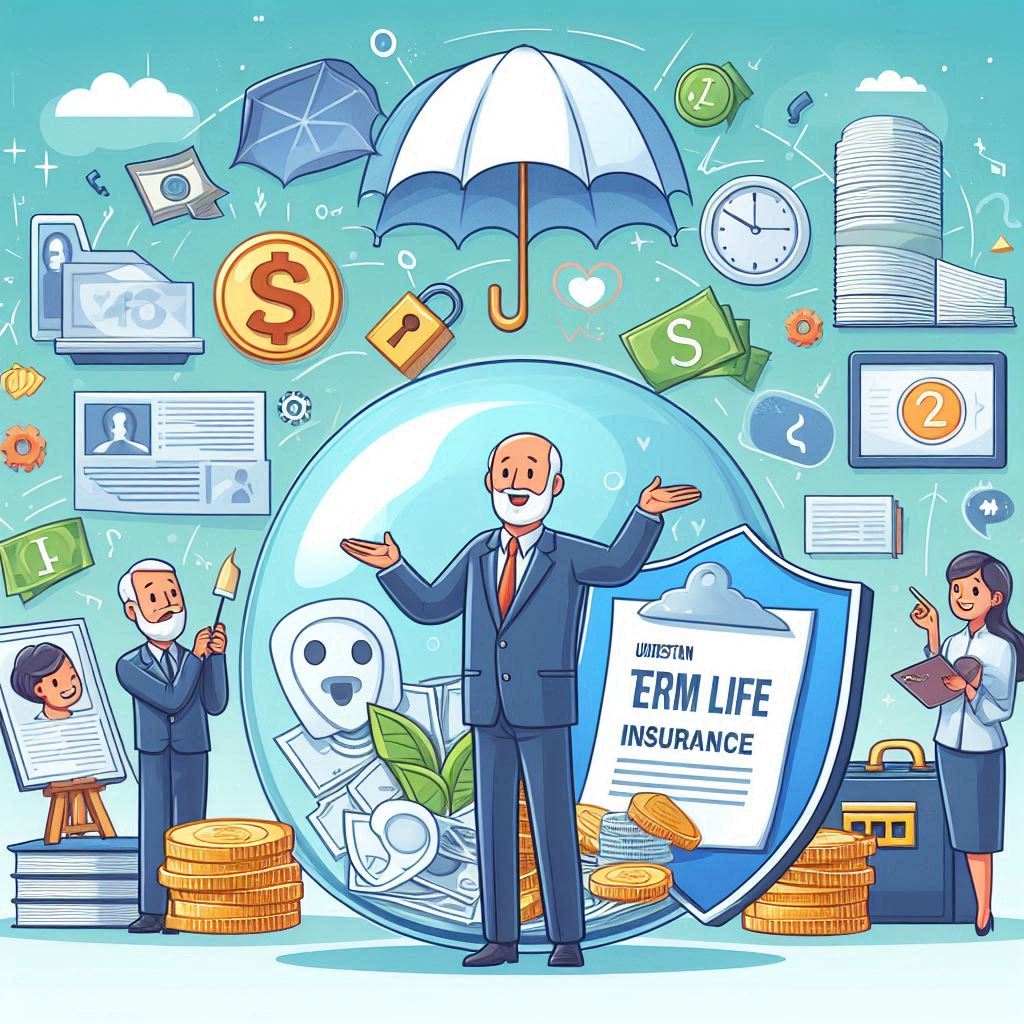Introduction
Term life insurance is one of the simplest and most affordable forms of life insurance available today. It offers a straightforward way to protect loved ones financially if the insured person passes away during a specified period. Often favored by families, young professionals, and individuals seeking a temporary safety net, term life insurance provides coverage without the commitment or higher premiums associated with permanent life insurance policies, such as whole life insurance. In this guide, we’ll take a comprehensive look at how term life insurance works, its features, and how to decide if it’s the right choice for your financial goals.
What is Term Life Insurance?

Term life insurance is a type of life insurance that covers an individual for a set period, often referred to as a “term.” Terms typically range from 10 to 30 years, with the most common options being 10, 20, or 30 years. If the policyholder passes away during the policy term, their designated beneficiaries receive a payout, known as the death benefit. If the policy term ends and the insured is still alive, the coverage expires, and no benefits are paid out unless the policy is renewed or converted.
This form of insurance is particularly beneficial for those who want financial protection during specific life stages, such as paying off a mortgage or raising children until they become financially independent.
How Term Life Insurance Works
Term life insurance policies function on a straightforward basis: you pay regular premiums to keep the policy active, and in return, your beneficiaries are guaranteed a death benefit if you pass away during the policy’s active term. The premiums remain fixed throughout the term, making it easier to plan financially. When the term ends, some policies allow you to renew coverage at a higher premium, or you can let the policy expire.
A major appeal of term life insurance is its flexibility. With different term lengths and coverage amounts available, you can tailor the policy to meet specific financial needs and goals. However, unlike permanent insurance options, term life policies do not build cash value or offer other investment benefits.
Key Features of Term Life Insurance
- Coverage Duration: Policies typically come in terms of 10, 20, or 30 years. Shorter terms are often chosen for temporary needs, like covering a specific debt, while longer terms provide protection for a more extended period.
- Fixed Premiums: Most term policies have fixed premiums, meaning you pay the same amount each period, which makes budgeting easier. Some policies, however, may offer flexible or increasing premiums.
- Death Benefits: This is the payout amount received by beneficiaries if the insured passes away within the policy term. The amount is chosen at the time of purchase and does not change.
- Renewal and Conversion Options: Some policies allow you to renew coverage at the end of the term or convert it to a permanent policy without a medical exam, which can be useful if your needs change over time.
Types of Term Life Insurance Policies

Level Term Life Insurance
Level term policies offer consistent death benefits and fixed premiums over the term’s duration. This is the most common type of term insurance, ideal for families looking for predictable coverage.
Decreasing Term Life Insurance
In decreasing term insurance, the death benefit gradually decreases over time, often in alignment with a mortgage or other debt repayment. It’s typically less expensive but offers less protection as time goes on.
Convertible Term Life Insurance
This policy type allows you to convert your term policy into a permanent policy (like whole life insurance) without undergoing a new medical exam, which is advantageous if your needs shift to long-term coverage.
Renewable Term Life Insurance
Renewable policies let you renew coverage at the end of each term, although premiums typically increase with each renewal. It’s a flexible option for those who may need insurance past the initial term.
Advantages of Term Life Insurance
- Affordability: Term life insurance is generally cheaper than permanent policies, allowing you to obtain substantial coverage at a lower cost.
- Flexibility: With various term lengths and coverage options, term life insurance can be tailored to meet specific financial obligations and life stages.
- Simplicity: The straightforward nature of term policies makes it easy to understand what you’re paying for and what your family will receive.
Disadvantages of Term Life Insurance
- No Cash Value: Unlike whole life insurance, term policies don’t accumulate cash value that can be borrowed against or used as savings.
- Temporary Coverage: Once the term expires, the coverage ends, which can leave you uninsured if you still need protection and the renewal premiums are unaffordable.
- Premium Increases with Renewal: Renewing a policy typically comes with increased premiums due to age and health considerations, which may make long-term renewals costly.
Term Life vs. Whole Life Insurance
Understanding the distinction between term and whole life insurance is crucial for selecting the right policy. While term life insurance is a temporary solution with lower premiums, whole life insurance provides permanent coverage with a cash value component. Whole life can be beneficial for estate planning and those who need lifelong coverage, but it is generally more expensive than term insurance.
In contrast, term insurance is ideal for individuals focused on specific, time-limited financial goals—such as covering a mortgage or providing for dependents until they become self-sufficient. Choosing between the two depends on your financial needs, budget, and the type of legacy you want to leave.
How to Choose the Right Term Length

Selecting the appropriate term length for your life insurance policy is one of the most critical decisions in the process. It’s essential to evaluate how long you’ll need the coverage based on your financial goals, dependents, and any major debts or obligations. Here are some steps to help you choose:
- Evaluate Financial Obligations: Determine your primary reasons for needing life insurance, such as mortgage payments, your children’s education, or income replacement for your spouse. Choose a term that aligns with these financial needs, for example, a 20-year term to match your mortgage duration or a 30-year term if you have young children.
- Consider Your Age and Health: Younger individuals often select longer terms since they typically have lower premiums and are healthier. For those over 50, a 10- or 20-year term may make more sense, aligning with retirement age and reducing premium costs.
- Align with Milestones: Look at specific life stages and milestones, such as retirement, children reaching adulthood, or achieving financial independence. Choose a term that protects your family until these milestones are reached.
- Planning for the Unexpected: While it’s hard to predict future financial needs exactly, a slightly longer term can provide a safety net. For example, if you’re unsure about a 20- or 25-year term, going with a longer term can ensure you’re covered in case you need it.
How Much Coverage Do You Need?
Determining the right amount of coverage can feel challenging, but there are simple methods to get an accurate estimate:
- Income Replacement: A common approach is to multiply your annual income by 10 to 15, ensuring your family has enough support for several years in your absence. This can cover living expenses, mortgage, and other essential costs.
- Debt and Expense Coverage: Calculate any outstanding debts, including mortgage, personal loans, and credit card balances, then add these to your coverage. This ensures that your family isn’t left with financial burdens.
- Future Expenses: Include estimates for major future expenses, such as college tuition for children or supporting an aging parent. You can research current education costs and plan for inflation to arrive at a reliable figure.
- Custom Calculation: Add together income replacement needs, debt, and future expenses, then subtract any assets or savings that could support your family. This net figure will give you a clear estimate of the coverage amount required.
Cost Factors for Term Life Insurance
Several variables impact the cost of term life insurance premiums:
- Age and Health: Younger, healthier individuals typically pay lower premiums because they’re at a lower risk of illness or mortality. Health conditions like hypertension, diabetes, or high cholesterol can increase rates.
- Policy Term and Coverage Amount: Longer terms and higher coverage amounts will result in higher premiums. A 30-year policy with a $500,000 death benefit will cost more than a 10-year policy for $100,000.
- Lifestyle Choices: Risky lifestyles, such as smoking, frequent alcohol consumption, or participating in extreme sports, generally result in higher premiums. Many insurers offer different rates for smokers and non-smokers.
- Family Medical History: A family history of serious illnesses, such as heart disease or cancer, can affect premiums, as it indicates a potential risk.
Common Myths and Misconceptions About Term Life Insurance
Understanding term life insurance is easier when you separate fact from fiction. Here are some common misconceptions:
- “If I Don’t Die Within the Term, It’s Wasted Money.” While it’s true that no payout is made if you survive the term, the purpose of term insurance is to provide peace of mind. Much like car or home insurance, the goal is to cover potential losses.
- “Only Breadwinners Need Life Insurance.” While income earners certainly need coverage, non-earning spouses contribute significantly through caregiving, house management, and more. Their loss could incur replacement costs like childcare, making life insurance valuable for both partners.
- “Young, Healthy People Don’t Need Life Insurance.” Although young people may not need extensive coverage, life insurance is typically cheaper when bought young and can protect against unforeseen health issues.
How to Apply for Term Life Insurance
The application process for term life insurance is straightforward:
- Choose Your Policy: Decide on the coverage amount, term length, and type of term insurance that best fits your needs. You can work with an insurance agent or use online tools for initial guidance.
- Submit an Application: The insurer will request personal information, including details on health, lifestyle, and family medical history.
- Medical Exam: Most term life policies require a medical exam to assess your health status. Some insurers may offer “no-exam” policies, but these can come at a higher cost.
- Approval and Policy Issuance: Once the application is reviewed, and your health status is assessed, the insurer will determine the premium. After approval, you can start your policy by paying the first premium.
- Tips for a Smooth Process: Make sure all your information is accurate. Misrepresentations can affect approval or result in higher premiums.
Renewing or Converting Term Life Insurance
Term life policies don’t last forever, but options are available at the end of the term:
- Renewal: You can renew the policy after the term expires, although the premium typically increases due to age. This option works if you still need coverage but don’t want a new policy.
- Conversion: Many term policies allow you to convert to a permanent policy, like whole life, without another medical exam. This option is helpful if your circumstances have changed and you want lifelong coverage.
- When to Consider Each Option: If you still need temporary coverage, renewing is a good choice. However, if you want a long-term safety net or are planning for estate purposes, conversion might be more beneficial.
Mistakes to Avoid When Buying Term Life Insurance
While buying term life insurance is straightforward, there are some common pitfalls:
- Underestimating Coverage Needs: Choosing too little coverage can leave your loved ones under-protected. Be realistic in calculating all financial needs.
- Selecting the Wrong Term Length: If you choose a term that’s too short, you may end up needing coverage again later, possibly at a higher premium. Think carefully about your future needs when selecting the term.
- Ignoring Renewal and Conversion Options: Many people forget about these options until the term is close to expiring. Being aware of renewal and conversion choices early can help you make a smooth transition when the time comes.
- Overlooking Insurer Reputation: Always choose a reputable insurer with strong customer service and claims handling records. A reliable company will ensure that claims are paid promptly and accurately.
- Skipping the Medical Exam: While it’s tempting to avoid a medical exam, policies that don’t require them can be more expensive. If you’re in good health, the exam could help you secure a lower premium.
Conclusion
Term life insurance provides essential financial protection for a defined period, making it a popular and affordable choice for individuals who want coverage without committing to a lifetime policy. With the flexibility to choose term lengths, affordable premiums, and high coverage amounts, term life insurance can provide peace of mind during key stages of life. However, it’s vital to choose a policy that aligns with your financial goals and needs.
If you’re considering term life insurance, take time to evaluate your financial situation, dependents, and major obligations. A well-chosen policy can protect your family’s financial future, giving you the confidence to focus on other important aspects of life.
FAQs
- Can I have multiple term life insurance policies?
- Yes, it’s possible to own multiple term life policies. Some individuals take out policies with different terms or amounts to cover specific needs, like mortgage payments or college expenses.
- What happens if I outlive my term life insurance policy?
- If you outlive your term life policy, coverage ends, and no death benefit is paid. Some policies allow renewal, though premiums may be higher due to age.
- Is it better to choose a shorter or longer term length?
- It depends on your financial needs. A longer term offers extended coverage but may come with higher premiums, while a shorter term can be more affordable but may not cover all future needs.
- Are there tax implications for term life insurance benefits?
- Generally, term life insurance death benefits are not subject to income tax, offering tax-free income to beneficiaries. However, there may be exceptions depending on state laws and specific policy structures.
- Can term life insurance be used as an investment tool?
- Term life insurance is not designed as an investment, as it doesn’t accumulate cash value. Its primary purpose is to provide a death benefit to protect your family financially.
